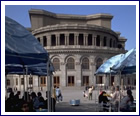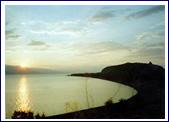Luckily there are many ways to go hiking over the weekend and most of them are accessible by train or bus from New York City. Possibly the most famous trail of all is the Appalachian Trail, which starts in Georgia and goes all the way up to Maine. But for day trips or a hike of a few hours, you can take a bus or train from the city.
The most popular way to get there is by train from Grand Central Station. There are two early morning trains that run on weekends only. The train will drop you off at a tiny station (Appalachian Trail station) that runs right through the trail. The walks North or South along the trail are both picturesque, but the South walk is possibly less strenuous and better for beginners. You first walk along planks through a swampy area. Then you enter a lovely forest area. Suddenly the forest ends and you are out in the open, in the middle of fields and farms. Walk along the sides of farms and you can wave hello to the cows and horses that inhabit them. The backdrop to these fields and farms are gorgeous mountains, which are especially picturesque in the autumn months when the colours of leaves change. Bring a camera as there are some lovely photo opportunities. Then cross the road and enter another forest area; but this one feels different to the last. You will see new types of plants and trees in this area. So the walk is a real feast for the senses and the trail keeps taking you through different terrain and landscapes. You can hike for either 3 hours or 5 hours before you have to get back to the tiny station for your return train to the city.
It is also possible to take the Metro North train to Cold Spring train station. There are many trails within walking distance of the train station but for the Appalachian Trail you have to go into the sports store near the station. It is one of the first stores you will see along Main Street when you leave the end of the platform. For a small fee, they provide shuttle service to the trail. It would be wise to book ahead but on weekends they have regular service for the many hikers that enjoy the area, especially in the warmer months. You are dropped off at the trail head and they pick you up at a specified time later in the day. The trains back to New York City run every hour.
Another route would be to take the bus to the Appalachian trail from Port Authority Bus Terminal (there is a bus that goes to Bear Mountain as well as to the Military Academy across the Hudson River). It is a 2-3 hour ride, but the bus leaves you right at the trail and then you have a few hours to hike before getting the bus back to New York. There are toilet facilities in Bear Mountain State Park, and also places to buy drinks or snacks. The Appalachian Trail runs directly through the park and there are also several other enjoyable trails in the area, including one around a large lake that is very picturesque.
Still another possibility is to take a bus from Port Authority to the Delaware Water Gap in Pennsylvania. The Gap is right on the border of Pennsylvania and New Jersey and the Appalachian Trail runs right through the town there too. It is a 2-3 hour ride and a short walk from the bus station through the middle of town to the trail itself. The town has a few shops and places to eat, and even trolley tours of the area (during the warm months only). Again, you can spend several hours exploring the area and hiking the trail before returning to New York City.
There is little excuse not to hike the famous trail and enjoy all the benefits of a walk in the woods. A tranquil break from the hustle and bustle of the Big Apple is always welcome.



 The majestic peaks of Mount Ararat provide a stunning
backdrop to Yerevan. The monastery of Khor-Virab and the ruins of
the ancient city of Dvin (dating back to the second century BC) are
located in the mid-distance Aerial view of Yerevan, capital of
Armenia Statue of Komitas, one of Armenia's most loved
composers, outside the Komitas Conservatory. Apart from writing
many original composition, Komitas travelled the country noting
down folk songs for posterity Yerevan, which is nestled in the
shadow of the snow-capped heights of the majestic mount Ararat,
where the Biblical Noah's Ark first landed escaping the Great
Flood, is the capital city of Armenia. With a population numbering
over 1.2 million, Yerevan is a bustling city. The central plaza,
Republic Square, is designed in the Armenian national style and
houses the Government House, the Cabinet and other governmental
offices as well as the Erebuni and Armenia hotels.
The majestic peaks of Mount Ararat provide a stunning
backdrop to Yerevan. The monastery of Khor-Virab and the ruins of
the ancient city of Dvin (dating back to the second century BC) are
located in the mid-distance Aerial view of Yerevan, capital of
Armenia Statue of Komitas, one of Armenia's most loved
composers, outside the Komitas Conservatory. Apart from writing
many original composition, Komitas travelled the country noting
down folk songs for posterity Yerevan, which is nestled in the
shadow of the snow-capped heights of the majestic mount Ararat,
where the Biblical Noah's Ark first landed escaping the Great
Flood, is the capital city of Armenia. With a population numbering
over 1.2 million, Yerevan is a bustling city. The central plaza,
Republic Square, is designed in the Armenian national style and
houses the Government House, the Cabinet and other governmental
offices as well as the Erebuni and Armenia hotels.
 Yerevan, the ancient capital of Armenia, extends you a
warm and friendly welcome. It is one of the oldest cities in the
world. The earliest recorded settlement there dates back to 782 BC.
King Argishty I founded a fortress city in the north-eastern part
of present-day Yerevan, with the following cuneiform inscription,
“With the majesty of God Khald, Argishty, son of Menua, built
up this inaccessible castle and named it Erebuni…” You can
still see relics from this part of our history at the Erebuni
Museum in Yerevan.
Yerevan, the ancient capital of Armenia, extends you a
warm and friendly welcome. It is one of the oldest cities in the
world. The earliest recorded settlement there dates back to 782 BC.
King Argishty I founded a fortress city in the north-eastern part
of present-day Yerevan, with the following cuneiform inscription,
“With the majesty of God Khald, Argishty, son of Menua, built
up this inaccessible castle and named it Erebuni…” You can
still see relics from this part of our history at the Erebuni
Museum in Yerevan.
 As you explore the many interesting sights in Yerevan, you will
learn about the culture and history of one of the world's
oldest nations.
As you explore the many interesting sights in Yerevan, you will
learn about the culture and history of one of the world's
oldest nations.